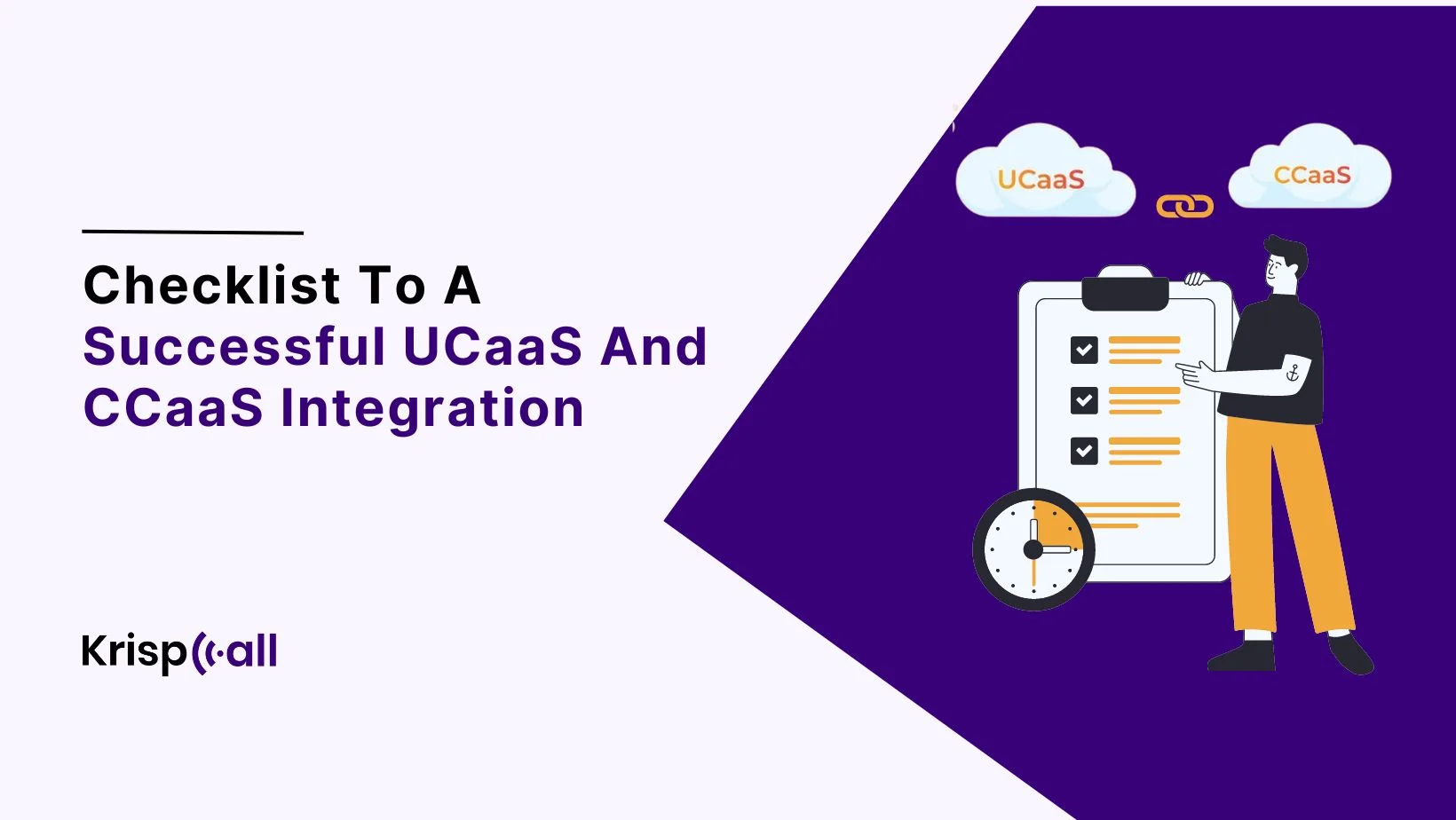Looking for a tailor-made checklist✅ to transform your business into a streamlined communication process? Or maybe you are not satisfied with your existing UCaas/CCaaS integration to its full extent.
Worry not the checklist presented in this blog serves as your roadmap to success.
This checklist works as a guide to navigating the complexities of UCaaS/CCaaS integration, ensuring a smooth transition, and maximizing the benefits of integrated communication solutions.
👓 Key Highlights
- UCaas/ CCaas both integrations are cloud-based solutions that provide all the required communication tools for your business from a single interface.
- By integrating UCaas and CCaas into your business you can get benefits such as enhanced customer experience, increased agent productivity, enhanced collaboration, operational efficiency & cost saving, and scalability & flexibility.
- To achieve a successful UCaaS/CCaaS integration, you need to define business needs & goals, choose the right integration provider, check network connectivity, plan for implementation & training, assess compatibility with existing infrastructure, evaluate & monitor procedures, and post-integration optimization.
- KrispCall helps you unlock the full potential of CCaaS with an ideal integration solution with its wide-range features, dynamic integration platform, and easy-to-use interface.
What is UCaaS integration?
UCaaS integration means linking your Unified Communication as a Service (UCaaS) system with other business platforms. When you integrate UCaaS with other apps, people can use all their communication tools in one place, without having to switch between different apps.
As a cloud-based solution, the platform offers various communication and collaboration tools for your business, including voice calls, video conferences, instant messaging, file sharing, collaboration tools, and more, all accessible as it operates in the cloud.
Let’s say you integrate UCaaS with a project management tool. This enables team members to begin voice or video consultations straight from the project workspace, promoting real-time collaboration.
What is CCaas integration?
CCaaS integration, which stands for contact center as a service integration that links your CCaaS platform with diverse business applications and services. As a result, this connection creates a unified contact center environment designed to boost agent efficiency and enhance customer interactions.
In CCaaS, all the essential tools and functionalities for running a contact center can be accessed through a cloud-based system. The most popular features are call routing & distribution, phone trees (IVR), omnichannel communication, call recording, and call monitoring.
The integration of CCaaS with a knowledge management system gives customer service agents access to relevant information during calls. In contrast, CCaaS can be integrated with a workforce management tool to optimize agent scheduling based on anticipated call volumes.
What are the benefits of integrating UCaas and CCaas?
- Enhancing the customer experience: Customer satisfaction largely depends on the speed at which you resolve their problems. Enhancing collaboration via integrated UCaaS and CCaaS can minimize wait times and boost the rate of resolving issues on initial contact. Research shows that integrating UCass/CCaas can achieve a 17% increase in customer satisfaction scores.
- Increased agent productivity: Integrating UCaas/CCaas at your business can highly enhance your agent’s productivity. It’s easy for agents to perform their tasks due to several factors including a unified interface where all communication tools are available in a single platform and automated workflow that saves agents valuable time.
- Enhanced collaboration: Utilizing both UCaaS and CCaaS will allow everyone to connect on an integrated platform. It improves internal communication between agents and departments. Collaboration also secures reliable communication regardless of location even with remote teams, and virtual phone assistants.
- Operational efficiency and cost saving: You can carry out daily operations efficiently and also save extra expenses once you integrate UCaas and CCaas into your business. The integration works as a centralized management that helps make data-driven decisions.
- Scalability and flexibility: As a cloud-based solution, there is no need to spend expenses on-premise hardware or software infrastructure. Companies can easily set up support centers in different regions globally whereas, the agents can work remotely from anywhere which provides flexibility.
7 Must have checklist for a successful UCaaS and CCaaS integration
1. Defining business needs and goals
To achieve a successful integration of UCaaS/CCaaS, begin by thoroughly understanding your business needs and goals. Are you aiming to enhance customer service interactions, increase agent productivity, or streamline collaboration among teams? Clearly outlining your desired outcomes will steer the integration process.
Make sure that key stakeholders from various departments (IT, customer service, sales, etc.) actively participate during the planning phase. This collaborative approach nurtures ownership and motivates users to adopt the integrated platform once it’s launched.
Companies with well-defined goals for their UCaaS/CCaaS integration experienced a 23% higher return on investment (ROI) compared to those with vague or undefined objectives.
By Frost & Sullivan
2. Choose the right integration provider
Look into potential providers and evaluate their expertise in integrating UCaaS and CCaaS platforms. Choose providers known for their strong reputation and experience in meeting the specific needs of your industry.
Take into account the quality of service and support provided by the service providers. Do they offer pre-sales consultations, demonstrate proficiency in project management, and provide continuous technical assistance after implementation? A reliable provider will seamlessly guide you through the integration process, ensuring a smooth transition for your organization.
For Example, If you prioritize a seamless integration experience with your existing CRM system. Choosing a provider with proven expertise and pre-built connectors for your specific CRM platform can significantly reduce integration complexity and ensure a smooth data flow between your UCaaS/CCaaS solution and CRM.
3. Check network connectivity
Check network connectivity to verify if your network can handle the new platform, and consider upgrading your internet connection if needed. Since UCaaS and CCaaS operate on cloud-based solutions, it’s crucial to have a strong network infrastructure to handle potential increases in call volume or data usage without experiencing any performance issues.
Poor internet bandwidth can lead to dropped calls, choppy video conferencing, and overall disruption to communication quality. Conduct network assessments to identify and address any potential bottlenecks or bandwidth limitations.
Perform thorough network testing before integrating your UCaaS and CCaaS platforms. This could involve tools like bandwidth tests, latency checks, and voice quality assessments.
According to a research organizations that addressed network bandwidth limitations before integrating UCaaS/CCaaS experienced 38% fewer call quality issues compared to those who did not.
By Nemertes Research
4. Plan for implementation and training
Consider a phased implementation approach to minimize disruption. This allows for testing, user training, and troubleshooting in smaller groups before a full-scale deployment. Develop a plan for data migration from existing systems to the integrated platform. Ensure user accounts are created with appropriate permissions and access levels.
Develop training materials that familiarize users with the functionalities and features of the integrated platform. This could include online tutorials, user guides, or in-person training sessions.
Develop a change management strategy to address potential user concerns and encourage the adoption of the new platform. This might involve communication campaigns, incentives, or dedicated support resources.
5. Assess compatibility with existing infrastructure
Compatibility issues between your existing systems and the new UCaaS/CCaaS solution can lead to delays, additional costs, and unexpected challenges during integration. Evaluate your current hardware and software to ensure they meet the technical specifications required for the UCaaS and CCaaS platforms. This might involve operating system compatibility, API availability, or specific hardware resources.
Consulting with the vendor or conducting interoperability tests between your existing systems and the UCaaS/CCaaS platforms. By proactively addressing compatibility issues, you can ensure a smooth integration process and avoid disruptions to your ongoing operations.
6. Evaluate and monitor procedures
Establishing performance benchmarks, meaning once the integration is complete, it’s essential to establish procedures for ongoing evaluation and monitoring. Define Key Performance Indicators to track the success of the integration. These might include call quality metrics, agent productivity measures, system uptime, or user satisfaction ratings.
Establish baseline performance levels for your chosen KPIs before the integration. Regularly monitor these metrics after implementation to identify areas for improvement or potential issues. It allows you to identify and address performance issues promptly before they significantly impact your operations.
The data insights by evaluating and monitoring also help you optimize resource allocation within your contact center. For example, identifying peak call times might prompt adjustments to agent scheduling to ensure adequate staffing during high-volume periods.
7. Post integration optimization
Fine-tuning for continued success by actively soliciting feedback from your team after they’ve had time to use the integrated platform. It can be done by conducting surveys, hosting focus groups, or encouraging open communication to gather valuable insights.
Analyze usage data from the integrated platform. Identify features that are frequently used and those that are less popular. Based on this data, consider tailoring user permissions or highlighting underutilized functionalities that could benefit specific teams.
Cloud-based solutions like UCaaS and CCaaS are constantly evolving. Stay informed about new features and updates offered by the service provider. Evaluate their potential benefits and consider incorporating them into your platform to enhance its capabilities.
Unlock the Full Potential Of CCaaS With Ideal Integration – KrispCall
If you are looking for a well-integrated CCaaS solution that provides advanced functionality and limitless integration platforms then KrispCall might be the one that you are looking for. As a cloud telephony system, KrispCall offers all the requirements solutions that a CCaaS needs.
When it comes to call management KrispCall offers some of the core telephony features that a CCaaS must have such as call routing that routes calls to the most appropriate agents based on factors like skills, availability, and caller data. Interactive voice response(IVR) that works as an automated menu to greet callers, collect information, and direct them to appropriate agents or departments.
CCaas is incomplete without features like call recording & call monitoring that help monitor your agent performance to identify areas for improvement. Finally call analytics that provides you with insights based on call volume, call duration, hold time, and other key metrics.
Enhance your operations with KrispCall’s integrated solutions. Integrate your CRM system for automatic caller information, optimize agent scheduling with workforce management tools, and empower agents with quick access to relevant knowledge during calls through knowledge base integration.
Conclusion
A successful UCaaS/CCaaS integration demands careful planning, thorough assessment of business needs, and strategic implementation. By following a comprehensive checklist, organizations can ensure a smooth transition and maximize the benefits of integrated communication solutions. Each step, from defining business goals to optimizing post-implementation, significantly contributes to achieving seamless integration and improving overall operational efficiency.
With KrispCall you can achieve an ideal CCaaS integration solution, offering versatile features and seamless compatibility with diverse business applications. It enables effortless integration of existing CRM systems, streamlines workforce management, and empowers agents with quick access to relevant information.
To enhance agent productivity and improve customer experiences through UCaaS/CCaaS integration you can try KrispCall free demo today!





